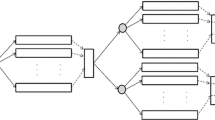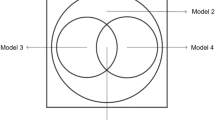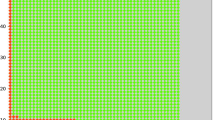Abstract
Many applications in telecommunications engineering lead to highly degenerate partitioned Markov chains of QBD type. In this paper, we study a traffic shaping scheme which is based on a generalization of the bucket method. The arrival process is modeled by a discrete Markovian arrival process. For this model, a detailed mathematical analysis leads to special algorithms involving matrices of lower order. The characteristics of the model are discussed from this viewpoint. Some performance measurements are derived and numerical examples are shown to demonstrate the effectiveness of the rate control scheme.
Similar content being viewed by others
Explore related subjects
Discover the latest articles, news and stories from top researchers in related subjects.References
C. Blondia, A discrete-time Markovian arrival process, PRLB-123-0015-CC-CD (August 1989).
C. Blondia and O. Casals, Statistical multiplexing of VBR sources: A matrix-analytic approach, Performance Eval. 16(1992).
U. Briem, T. Theimer and H. Kröner, A general discrete-time queueing model: Analysis and applications,Proc. 13th Int. Teletraffic Congres, Copenhagen, 1991.
J. García and O. Casals, Stochastic model of space priority mechanisms with Markovian arrival processes, Ann. Oper. Res. 35(1992)271–296.
B. LaguË, C. Rosenberg and F. Guillemin, A generalization of some policing mechanisms,Proc. IEEE INFOCOM'92.
D. Liu and M.F. Neuts, Assessing the effect of bursts of arrivals on the characteristics of a queue,Proc. IMSIBAC 4, San Sebastian, Spain, 1992.
D. Liu, Some traffic shaping procedures for ATM networks, Ph.D. Dissertation, University of Arizona (1993).
D.M. Lucantoni, K.S. Meier-Hellstem and M.F. Neuts, A single server queue with server vacations and a class of non-renewal arrival processes, Adv. Appl. Prob. 22(1990)676–705.
D.M. Lucantoni, New results on the single server queue with a batch Markovian arrival process, Stoch. Models 7(1991)1–46.
S. Narayana and M.F. Neuts, The first two moment matrices of the counts for the Markovian arrival process, Stoch. Models 8(3)(1992).
M.F. Neuts,Matrix-Geometric Solutions in Stochastic Models: An Algorithmic Approach (The Johns Hopkins University Press, Baltimore, 1981).
M.F. Neuts,Structured Stochastic Matrices of M/G/1 Type and Their Applications (Marcel Dekker, New York, 1989).
M.F. Neuts, A versatile Markovian point process, J. Appl. Prob. 16(4)(1979).
M.F. Neuts, D. Liu and S. Narayana, Local Poissonification of the Markovian arrival process, Stoch. Models. 8(1)(1992).
C. Ohta, H. Tode, M. Yamamoto, H. Okada and Y. Tezuka, Performance analysis of a rate control scheme for ATM networks, Technical Report No. SSE91-143 (1992), IEICE (Institute of Electronics, Information, and Communication Engineers), in Japanese.
C. Ohta, H. Tode, M. Yamamoto, H. Okasa and Y. Tezuka, Peak rate regulation scheme for ATM networks and its performance,Proc. IEEE INFOCOM'93, San Francisco, 1993, to be published.
E.P. Rathgeb, Modeling and performance comparison of policing mechanisms for ATM networks, IEEE J. Select. Areas Commun. SAC-9 (April 1991).
G. Rigolio and L. Fratta, Input rate regulation and bandwidth assignment in ATM networks: An integrated approach,Proc. 13th Int. Teletraffic Congress, Copenhagen, 1991.
Author information
Authors and Affiliations
Additional information
This research was supported in part by Grant No. DDM-8915235 from the National Science Foundation.
Rights and permissions
About this article
Cite this article
Liu, D., Neuts, M.F. A queueing model for an ATM rate control scheme. Telecommunication Systems 2, 321–348 (1993). https://doi.org/10.1007/BF02109864
Received:
Revised:
Issue Date:
DOI: https://doi.org/10.1007/BF02109864




